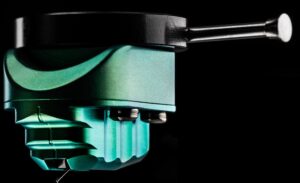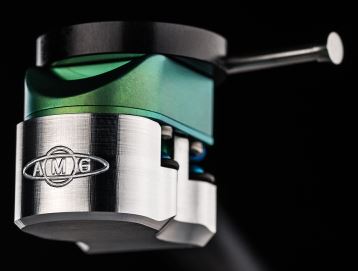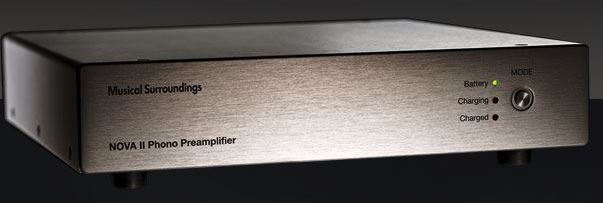AMG has received a mountain of positive press over the past couple of years with their high performance Viella 12, AKA ‘V12’, turntable. This turntable has been included in display systems by a significant number of exhibitors at various audio shows in lieu of brands that might be more familiar to the audio public. Now, AMG has launched a moving coil phono cartridge with hopes that it, too, will make a large and immediate impact in the very competitive marketplace of phono cartridges.

At a suggested list price of $2,750, I was expecting mid-level performance but was jolted out of my preconception to find that the Teatro is a true high-end product with near state of the art performance. AMG is based in Germany and distributed in the US by Musical Surroundings. Here is an edited description from the Musical Surroundings’ Web site.
The AMG Teatro moving-coil phono cartridge represents the cumulative work of the AMG design team and an international group of manufacturers, including an aerospace machinist in Tacoma who makes the titanium body. The Teatro’s unique 2-piece titanium body provides a high strength-to-weight ratio and is dimensioned to minimize resonance and reflected energy. The coils are wound with Ohno cast (OCC) mono-crystal high-purity oxygen-free copper wire. Neodymium magnets are combined with a soft magnetic alloy yoke consisting of cobalt and iron to produce an output of .4mV at 5cm/sec. Coil impedance is 12Ω. A solid boron cantilever with a diameter of .26mm is fit with a line contact stylus (40 x 7µm) and the dynamic compliance is 18 x 10-6 cm/dyne. The Tiodize Type III titanium body is tapped for 2.5mm mounting screws and the output pins are also PC-OCC (Pure Copper Ohno Continuous Casting). The recommended tracking force is 2 grams. A precision machined stylus protector, used when transporting and mounting, is included. Still in the box, the Teatro makes a very positive first impression.
Other components on hand included Mark Levinson No. 52 and Bent Audio Tap-X preamplifiers, Basis 2500 Signature turntable with Vector 4 tonearm, VPI Aries 3D turntable with 10” printed tonearm, Miyajima Madake moving coil cartridge, Sutherland DUO, the new RCM Sensor 2 and Jasmine LP 3.0 phono preamplifiers, Cary DAC-100t and DAC-200ts DA converters, Auralic Vega and PS Audio DirectStream DA converters, and Lynx Hilo AD/DA converter. The source for all things digital is a custom DAW/PC/music server running JRiver Media Center 19. At the end of the chain are Acoustic Imagery Atsah amplifiers and Magnepan 3.7 loudspeakers. The Magnepans have had significant upgrades with the installations of Audio Horizons Platinum Reference fuses and Mye stands. PSB Imagine T speakers from the home theater system are often used to validate findings in this system. The interconnects are Audioquest WEL Signature XLR and Mogami XLR. Power protection and purification are provided by a PS Audio Dectet for the preamplifiers and source components, and a PS Audio Quintet for the power amplifiers. The latter provides remote turn-on and -off of the power amplifiers. This is a high performance audio system.
The first thing one hears from the Teatro is nothing. This cartridge, possibly due to the complex shape of the titanium body, has the quietest backgrounds that this listener has ever not heard. There is an amazing lack of any hint of obscuring noise or distortion that allows every note and sound to spring from non-existence into immediate presence in the sound field. The effect is startling. The result is that low level resolution and clarity, noticeable in the extraordinarily long decay of notes and added subtlety and inflection of vocals, seems to be enhanced.

Another strength of the Teatro is its tracking ability which is always excellent and provides outstanding clarity. This makes it wonderfully easy to follow a particular musician or section in the orchestra, or even a background singer. On Joe Jackson’s “Breaking Us In Two” on the Night and Day MFSL Original Master Recording LP, Jackson’s voice was right there! The perception that I was listening directly, without the presence of electronics, was compelling. The sound quality from this LP was often perfect, or so it seemed.
Paul McCartney’s voice was remarkably convincing on “The Girl Is Mine” on Michael Jackson’s (yes, another Jackson) Thriller LP. His voice had a very natural and realistic and uncommon depth that reached into the smallest nuance. Sir Paul’s mood could even be discerned. In fact, all singers sound wonderfully rich and complete.
Thriller provides many examples of the dynamic punch and power of the Teatro. There is ample and correct large volume changes with no lag at the start or hangover at the end of an impulse. This outstanding macro dynamic performance might be another benefit of the titanium body. Small scale dynamic shifts are also delivered with excellent nuance and subtlety.
The treble is very clean and refined. I have been finding that some modern cartridges can sound better with higher loading values than we assumed were necessary. With low distortion electronics and cabling, many cartridges sound more open and have more realistic treble harmonics when loaded at 2 to 3 times the old recommended values. Even though the Teatro’s recommended loading is 120 to 500 Ohms, I reveled in the Teatro’s clarity when the loading was set to 1,000 Ohms. This value could result in an occasional sense of unwelcome crispness, but most recordings sounded much better with this higher value. That sense of air and openness, with a pure, extended treble was wholly satisfactory on the majority of recordings.
A significant strength of the Teatro is the cohesive, even handed, linear overall sound from a noticeably deep and powerful bass up through a very human sounding midrange. This continues with little change in character to beyond audibility. This is a remarkable achievement: a characterless presentation is the goal of each and every phono cartridge on the planet.
The sound stage is pinpoint, stable and huge. The height is a bit less than the $5,900 Miyajima Madake and the very deepest part of the stage, which is apparent on only a few of the very best LPs, is definitely audible if pulled slightly upstage. The Madake carves out the body of performers with a little more focus and shape, but the difference is not really significant in terms of enjoying the performances. The Miyajima cartridge is also a tad cleaner in the upper frequencies. These relative traits aside, the Teatro is a fine cartridge and easily competitive in the $5k or more ballpark. I have heard – and owned – more expensive cartridges that were not as objectively proficient or as subjectively enjoyable.
At this level of performance, you are probably looking at cable upgrades and audiophile fuses for sonic improvements. The Teatro could hold its own in six figure audio systems. Three thousand dollars is a threshold price point, above which unit sales decline. To be purchased and enjoyed by a greater number of audiophiles, a cartridge should be price below this threshold. This was a goal of AMG and the Teatro not only meets this condition, but its excellent overall performance warrants a serious look by anyone considering a new cartridge. You might seriously consider having a long term relationship with the AMG Teatro. It is that good!

Now let’s take a look and listen to the $1,200 Nova II phono preamplifier. The Nova II is designed by Mike Yee and produced and manufactured by Musical Surroundings in California. The new Nova II is a battery-powered phono stage that replaces the popular Nova Phonomena. To help keep the costs low, it shares some chassis components of the MYDAC II and features dual-mono, discrete circuitry with extensive gain and loading flexibility. The Nova II has rear panel accessible switches for gain and loading adjustment. Gain is adjustable in 13 increments from 40 to 60 dB, while loading options include 17 settings from 30 to 100k Ohms. There are two rechargeable internal NiMH battery packs with “Smart Sensing” auto recharge feature inside the compact chassis. All AC and charging circuits are disconnected when listening in battery mode. Charging the batteries for one hour will provide about 3 hours of listening time. I did not discover how long a full charge will last.
Like the Teatro cartridge, the Nova II’s background noise is extremely low. This is probably helped by the dual-mono battery power, in addition to careful design of the amplifying circuitry. Break-in is in the 100-150 hour range. After this necessary chore, the intrinsic sound character is not hard to pin down. The upper frequencies are pure and true with a very tube-like reluctance to exacerbate any coarseness in the recording. A strong sense of very good resolution is obviously at play.
The Nova II provides outstanding bass reproduction. The extreme quietness helps the bass come through with power and detail. The sound stage is well focused and stable. The ability to feel the size and acoustics of the recording space is often thrilling with a rush of positive responses to the music.

A guitar player might say the Nova II has “tone”. The overall sound leans towards the warm and rich, as opposed to any hint of a typical solid state thin and lean sound. This character is very linear across the musical spectrum. Music sounds natural and enjoyable listening sessions are the norm.
This is a serious component and is competitive with the very best in some areas, such as lack of harshness and background silence. The quiet backgrounds help to offer high resolution, while the $4,500 RCM Sensor 2 offers more micro resolution and plays at an even higher level. The Nova II sounds far less electronic and is more musically refined than the $950 Jasmine LP 3.0.
The Nova II is a very musical phono preamplifier that is always enjoyable and entertaining. Based on the level of performance it offers, it is a bargain at the asking price. I enjoyed my time with the Nova II and felt no compelling urgency to reconnect any of the other more costly phono preamps that were available in the current inventory. The Nova II is worth hearing for yourself.
Overall Ratings
AMG Teatro: 9.5 LPs
Nova II: 8.5 LPs
Link to Manufacturer/distributor: Musical Surroundings
